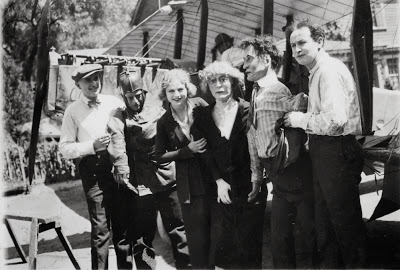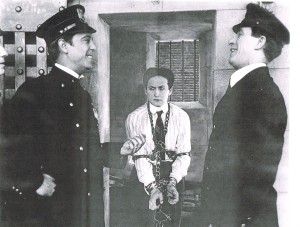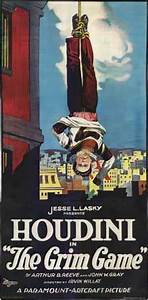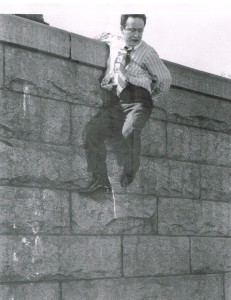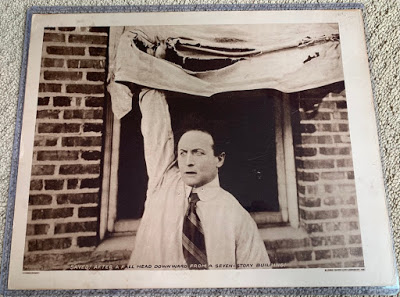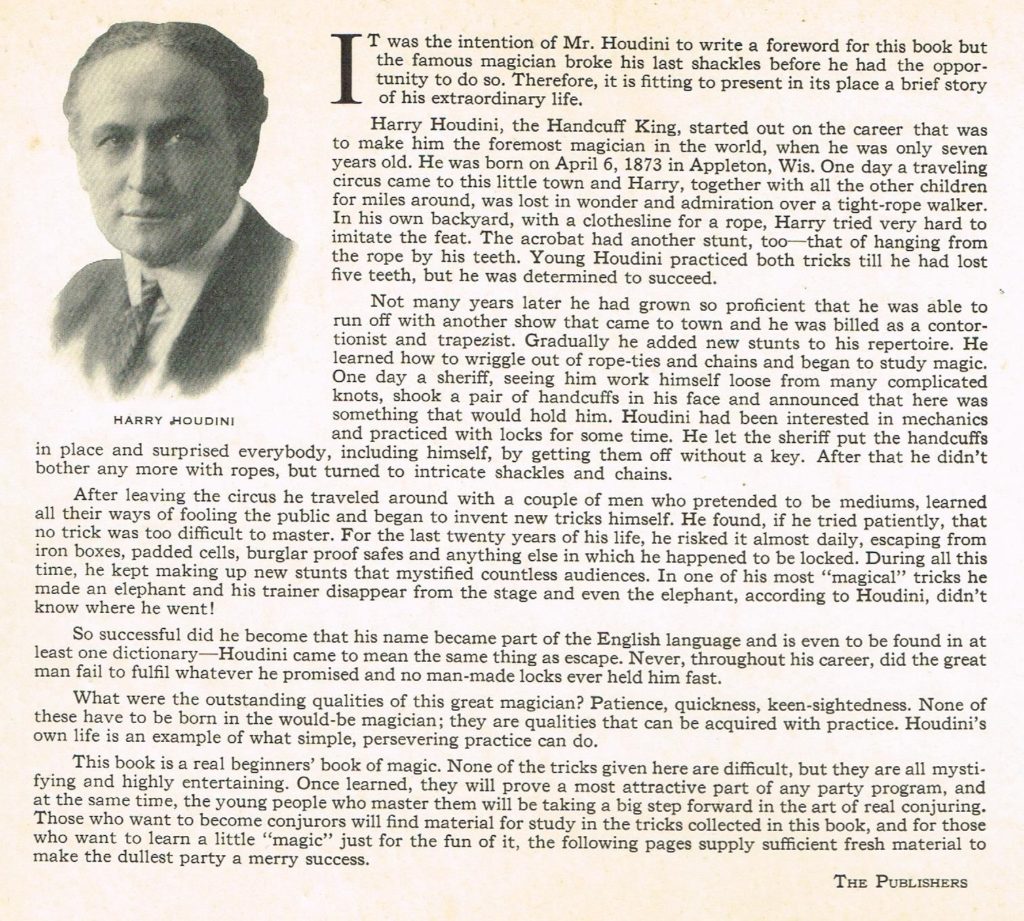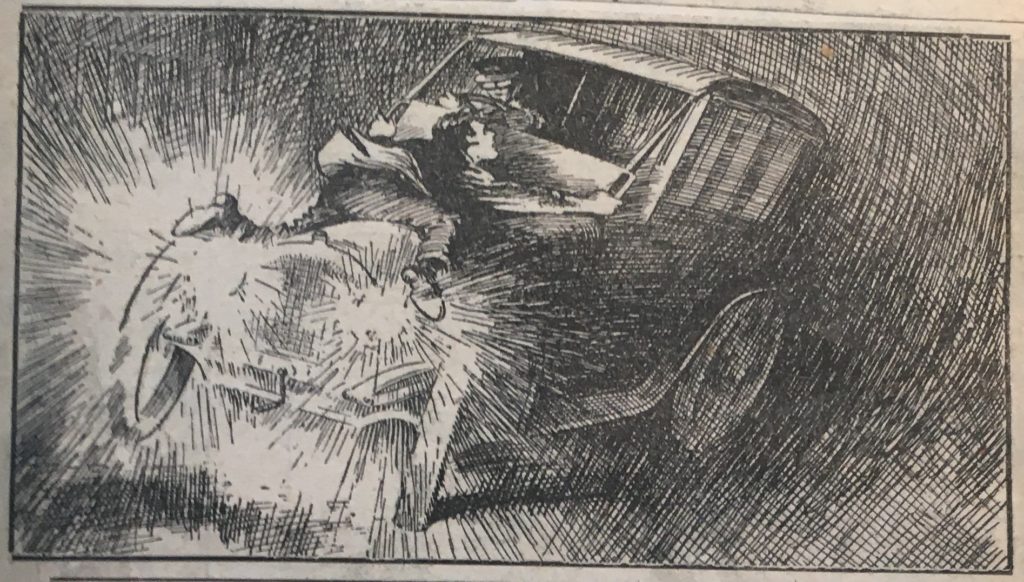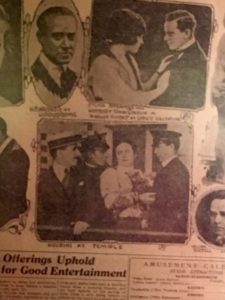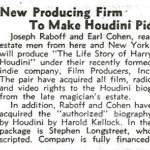 In 1950, Film Producers, Inc was going to make a Houdini Pic. They commissioned a 150-page screenplay (June 25, 1950) by Stephen Longstreet which led to a 172-page screenplay by Endre Bohem and Hilda Gordon (August 29, 1950).
In 1950, Film Producers, Inc was going to make a Houdini Pic. They commissioned a 150-page screenplay (June 25, 1950) by Stephen Longstreet which led to a 172-page screenplay by Endre Bohem and Hilda Gordon (August 29, 1950).
Below is a summary of the 172-page screenplay:
It is Halloween in New York City and the year is 1927 – the first anniversary of the Great Houdini ‘s death. In accordance with his instructions, a group assembles in a bare room of his house on 113th Street to conduct a séance in the hopes that Harry Houdini can return to them. Among them are Bess, his attractive beloved wife, in her middle forties; Roy, sixty, his manager; Tony, fifty, his best friend; Dr. Jamieson and Dr. Schaeffer, scientists; Joe Quinn, a reporter. A sealed envelope left by Houdini is opened and read by Tony. Houdini promises to come back tonight if he can, and to help him he wants his friends to concentrate on him. Each of them has a different thing to remember. Tony will remember him as a child, when he was still little Ehrich Weiss…
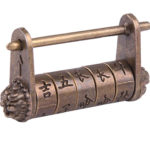
Ehrich is only thirteen when he astounds his pal Tony and their school teacher by mysteriously getting out of a locked classroom where he is supposed to remain as punishment for not paying attention. Ehrich then runs off to the carnival grounds where he accepts the challenge of Roy and Stella Comstock, a young couple performing cycling and magic stunts, to duplicate the great needle trick. Ehrich is bound, suspended head first and picks up the needle with his eye-lid. Roy is impressed and offers Ehrich a job, but the boy insists on having his five dollars instead. With it Ehrich buys a coveted Chinese puzzle lock from the junkman and exasperates Mama Weiss and Tony with the long hours he spends before he finally opens it. Mama is a pleasant, careworn woman, who resignedly realizes that her beloved Ehrich is a problem boy who may spend all his life trying to find the answers to mysteries…
By the time Ehrich is in his early twenties, he is performing as a magician with Roy and Stella Comstock and gets billing as “The Great Houdini.” During a show at a high school auditorium, Houdini selects the pretty, eager Bess Rahner from the audience to assist him. A pebble from a small boy’s slingshot breaks the beaker of chemical water and ruins Bess’s dress, but this give Houdini an excuse to make amends and see Bess again. Despite the opposition of Bess’s stern mother, a romance develops between them and leads to an early marriage, which alienates Bess and her mother. Mama Weiss, however is very pleased that her son has found as pretty and sweet a girl as Roy’s Stella…
Bess’s first appearance at a third-rate theater as Houdini’s assistant finds her frightened, and angry with Houdini for making her wear tights, but his glib patter and sensational feats of magic overcome her fear, and afterwards he kids her out of her anger…
Houdini constantly practices new stunts and escape routines, and hoping to get into big-time vaudeville, he and Bess go to Detroit with Roy and Stella for an audition. They are booked, but when Houdini tries to escape from a strait-jacket, he finds he hasn’t yet mastered it and as a result they all lose their jobs. To get fare back to New York, Houdini performs a daring stunt by being handcuffed, leg-ironed and weighted, then diving through a hole in the ice into the Detroit River. Bess, Stella and Roy, in the waiting crowd, become panicky when Houdini fails to come up. Roy is on the point of going after him, when Houdini at last emerges triumphantly, having located the hole in the ice barely in time. This stunt is highly publicized by Joe Quinn, a young newspaperman, and as a result Houdini accepts a lucrative offer from the Orpheum Circuit and hires Joe as his press agent. Realizing he will be doing daring stunts for the rest of this life, Houdini feels it’s wrong to ask Bess to face the torture of having to stand by and wait and never be sure he’ll emerge alive, but Bess shares his confidence in himself as well as returning his love and she insists on sticking with him…
Houdini becomes well-known as an escape artist. When he appears at the Palace Theater in Pittsburgh, Tony, Mama Weiss and Mrs. Rahner, Bess’s mother whom Mama has as last gotten to accept her daughter’s marriage, are in the audience. Houdini escapes from an ancient Chinese water-torture chamber, but in the process his ankle is broken. Tony, who is studying medicine, tries to make Houdini take proper care of his ankle, but Houdini insists on keeping his engagements in New York…
Houdini confounds the N.Y. police by escaping from a locked cell in the Tombs. Then, although his ankle is still in a cast, Houdini, dangling head downward and supported by ropes, works himself out of a strait-jacket, has he is lowered from a building in Times Square…
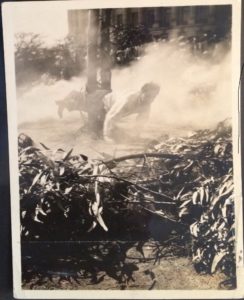
Photo courtesy of Fred Pittella
On tour across the country with Bess, Houdini continues to perform more and more spectacular escape stunts and he becomes famous for them and for his showmanship. When he learns that Stella has been injured during the performance of her and Roy’s bicycle act, he talks them into going to London to look over the act of a Harvey Houdini who claims that Houdini is imitating him. Houdini wants Roy to set up a way for him to debunk the phony. Meanwhile, Houdini buys a home for Bess in New York, and has Mama Weiss and Mrs. Rahner get it in shape so they can move into it when they return from England. Before they go, Houdini performs an escape feat for an assemblage of Boy Scouts in which he is tied to a stake from which he has to free himself before a ring of fire envelops him. It very nearly leads to his being burned to death since kerosene has been used on the fire. Afterwards Tony, now a doctor, warns Houdini that he must give his body a chance to recover from the many beatings he’s been giving it. Houdini refuses to do so, but insists that Tony go abroad with him and Bess to be on hand for occasional checkups.
Aboard ship, Houdini and Bess amuse the passengers by conducting a séance, but it disturbs Houdini when one of his guests, a Dr. Schaeffer, insists on taking the supposed message from his dead son seriously…
In London, Houdini cleverly debunks the trickery of the phony Houdini, making the latter a laughingstock to the audience…
Houdini captivates Europe with his fantastic feats, but in Paris he has a narrow escape from a trickily locked safe when an attendant tampers with the lock…
In Russia, the Secret Police are furious when Houdini pulls off the impossible feat of escaping from a large safe-like metal box-car. Celebrating afterwards with Bess, Stella and Roy at a nightclub, Houdini witnesses Hindu Ramandra’s endurance test of remaining locked in an air-tight coffin for eighteen minutes. Houdini determines to do the stunt the next night and remain inside twice that long, despite Bess’s apprehension. However, Houdini doesn’t get to perform this feat, for the critical illness of his mother sends them all hurrying back to New York.
Mama Weiss dies before Houdini gets there, and he becomes haunted by a fragmentary message to him which she was unable to complete – a message about something he should know about. Houdini feels that it may be possible to contact Mama and with the worried and understanding Bess, he investigates the possibilities through various mediums, all of whom he finds to be fakes. He discovers that Dr. Shaeffer is being duped by these phonies, and he launches a crusade to expose them, giving lectures and staging exposes, with Bess’s help. A Dr. Jamieson, head of a psychological foundation, enlists Houdini’s aid in exposing the famous Angelus Sisters, which Houdini does by duplicating their supposed spiritual phenomena by mechanical means. But this whole business seems to depress Houdini and to get him interested in his former feats, Roy gets Ramandra to challenge him. At the Hippodrome Theatre, Houdini astounds the world by remaining in a sealed, airtight glass casket for an hour and thirty-one minutes. However, afterwards, Houdini seems like a changed, broken man, and Bess becomes frantic with worry because she can’t seem to reach him at all. She is very apprehensive when several months later, Houdini insists on being locked in a sealed casket and buried in a grave. When he remains inside for three and half hours, Bess suffers agony, but at last, he frees himself and, like a frightening apparition, emerges from the earth…
Bess thinks it a miracle that Houdini is now his cheerful self, and he asks her forgiveness for having had to undergo this experiment which he hoped would put him in touch with his mother. While it failed, he feels that perhaps after his death, he may be able to contact Bess…
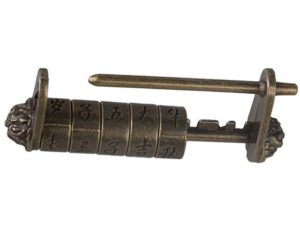 And so, a year after the death of the Great Houdini, Bess and his friends are assembled in the hope that Houdini will return. They sit in expectant silence with Bess nervously playing with Houdini’s Chinese puzzle lock, which she’s always carried for good luck. They wait many minutes past the scheduled time, and then Bess suddenly is elated to discover that the puzzle lock, which no one has ever opened except Houdini, is now open. She took tenderly at Houdini’s photograph and it is almost as if he were smiling…
And so, a year after the death of the Great Houdini, Bess and his friends are assembled in the hope that Houdini will return. They sit in expectant silence with Bess nervously playing with Houdini’s Chinese puzzle lock, which she’s always carried for good luck. They wait many minutes past the scheduled time, and then Bess suddenly is elated to discover that the puzzle lock, which no one has ever opened except Houdini, is now open. She took tenderly at Houdini’s photograph and it is almost as if he were smiling…
Credits:
- Summary Snippets courtesy of Paramount Files at Margaret Herrick Library
Related:

